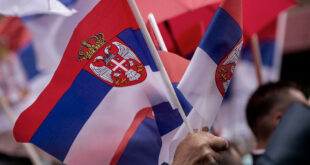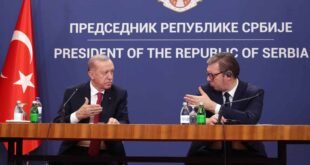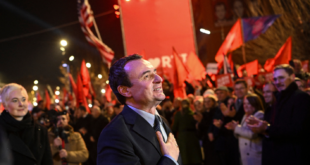Radovan Karadzic once again questioned facts established previously by the ICTY regarding the massacre at the Markale market during the Bosnian war, in an apparent effort to get confirmation from the prosecution witness that the incident was staged by the Bosnian government.
In order to prove his claim, Karadzic presented a video from the Markale market in Sarajevo on 5 February 1994, which showed empty tables in one part, and dead bodies in another. He said that some of the bodies were dummies and some were corpses of soldiers who were killed earlier and brought to the market.
The prosecution asked for the authenticity of the video, and Karadzic replied that the video was recorded by “Muslim television” in Sarajevo and shown only once “by mistake”. After that, according to Karadzic, only the edited version of the same video was shown on television.
In February 1994, 67 people were killed and 142 wounded in an artillery attack on the Markale marketplace. General Stanislav Galic, who was head of the Sarajevo Romanija Corp of the Army of Republika Srpska, VRS, based around Sarajevo from 1992 to 1996, has been sentenced to life for the massacre and other crimes after being convicted by the International Criminal Tribunal for the former Yugoslavia, ICTY.
Karadzic, the wartime Bosnian Serb leader, has been indicted by the ICTY for the same crime. He was supreme commander of the VRS during the war and the political leader of Bosnian Serbs during the war.
The Trial Chamber did not immediately accept the video Karadzic presented today as evidence, saying that it was necessary to check the tape’s authenticity.
David Harland, a former UN official in Bosnia whose 14 hours of cross-examination ended today, said that parts of the video shown in the courtroom he had never seen before.
“This is very weird,” Harland said. “I would like to see the original recording, too. I have never seen this video. What I know about the massacre is from people who survived it and from those who came to Markale immediately after the massacre was committed.”
Karadzic asked Harland what UNPROFOR had concluded in its investigation after the massacre, claiming that two reports were issued, one blaming the Bosniak (Bosnian Muslim) government for the attack and another blaming the Bosnian Serb forces.
Harland answered that UNPROFOR had never had any doubts about the number of people wounded and killed, and that their investigation indicated that Bosnian Serb forces were the culprits, but that “empirical proof” was never obtained.
Harland also told Karadzic that he was contradictory in his claims about Markale.
“At the same time you are saying that the massacres never happen and that it was staged? It is very contradictory to me,” Harland said
Karadzic did not reply to the comment.
During the cross-examination, Karadzic repeated claims that people in Sarajevo under the siege were heavily armed, and often opened fire at Bosnian Serb positions. He asked the witness how many shells were generally fired during one day in Sarajevo.
“It varied from day to day, from month to month. But, approximately, several hundred a day,” Harland replied, adding that most of the shells came from Bosnian Serb positions around the city.
He also said that UNPROFOR identified three types of targets for Bosnian Serbs: tactical targets close to the front lines; military targets; and civilian targets. Harland said that the UN was worried because civilian targets were more often exposed to shelling than military targets.
The next hearing in Karadzic’s trial is scheduled for Wednesday, May 19.
 Eurasia Press & News
Eurasia Press & News


